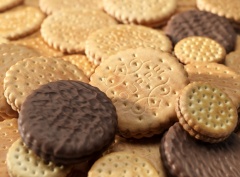Biscuits
| Infobox on Biscuits | |
|---|---|
| Example of Biscuits |  |
| Facts | |
| Origin | - |
| Stowage factor (in m3/t) | - |
| Humidity / moisture | - |
| Oil content | - |
| Ventilation | - |
| Risk factors | See text |
Biscuits
Description / Application
A biscuit is a baked, commonly flour-based food product. The term is applied to two distinctly different products in North America and the Commonwealth Nations and Europe.
In the United States and Canada, it is a small, soft, leavened bread, somewhat similar to a scone, though generally softer and fluffier. Although yeast may be used as a leavening agent, it is often replaced or supplemented with baking powder or baking soda. A Southern regional variation on the term, beaten biscuit, is closer to the British variety.
In Commonwealth English, it is a small and generally sweet baked product that would be called either a cookie or a cracker in the United States, and a cookie (biscuit in Quebec) in Canada. In Newfoundland, the British term is used, whereas the American "biscuit" is virtually unheard of, and not a popular food item in the province. Biscuits in the United Kingdom and Ireland may be savoury (savoury biscuits are often referred to as "crackers") or sweet, such as chocolate biscuits, ginger nuts, custard creams or the Nice biscuit. Although in Commonwealth Nations the term "cookie" may be synonymous with "biscuit", a cookie is generally a softer baked product.
Biscuits today can be savoury or sweet, but most are small at around 5 cm in diameter, and flat. The term biscuit also applies to sandwich-type biscuits, wherein a layer of "creme" or icing is sandwiched between two biscuits, such as the custard cream, or a layer of jam (as in biscuits which, in the United Kingdom, are known as "Jammy Dodgers").
Sweet biscuits are commonly eaten as a snack food, and are, in general, made with wheat flour or oats, and sweetened with sugar or honey. Varieties may contain chocolate, fruit, jam, nuts, or even be used to sandwich other fillings. Usually, a dedicated section for sweet biscuits is found in most European supermarkets.
In Britain, the digestive biscuit and rich tea have a strong cultural identity as the traditional accompaniment to a cup of tea, and are regularly eaten as such. Many tea drinkers "dunk" their biscuits in tea, allowing them to absorb liquid and soften slightly before consumption.
Savoury biscuits or crackers (such as cream crackers, water biscuits, oatcakes, or crisp breads) are usually plainer and commonly eaten with cheese following a meal. Other savoury biscuits include the Jewish biscuits known as matzos. Many savoury biscuits also contain additional ingredients for flavour or texture, such as poppy seeds, onion or onion seeds, cheese (such as cheese melts), and olives. Savoury biscuits also usually have a dedicated section in most European supermarkets, often in the same aisle as sweet biscuits. The exception to savoury biscuits is the sweetmeal digestive known as the "Hovis biscuit", which, although slightly sweet, is still classified as a cheese biscuit. Savoury biscuits sold in supermarkets are sometimes associated with a certain geographical area, such as Scottish oatcakes or Cornish wafer biscuits.
In general, Australians, South Africans, New Zealanders, Kenyans, Indians, Pakistanis, Sri Lankans, Singaporeans, and the Irish use the British meaning of "biscuit" for the sweet biscuit. In both Canada and Australasia, the terms biscuit and cookie are used interchangeably, depending on the region and the speaker, with biscuits usually referring to hard, sweet biscuits (such as digestives, Nice, Bourbon creams, etc.) and cookies for soft baked goods (i.e. chocolate chip cookies). Two famous Australasian biscuit varieties are the ANZAC biscuit and the Tim Tam. This sense is at the root of the name of the United States' most prominent maker of cookies and crackers, the National Biscuit Company, now called Nabisco.
Shipment / Storage / Risk factors
Packed in airtight tins in cases. Owing to the dampness of tropical climates, cardboard boxes are not advisable.
Packing is usually good, but tin containers, often being of very light gauge metal, are easily crushed and dented. It is a fairly common occurrence to find tins in this condition in cases externally intact and in good order. An unevenly placed coating of sugar on biscuits may of itself result in their being delivered in a broken condition. Biscuits should be given dry, well ventilated stowage, and storage away from odorous cargoes.











